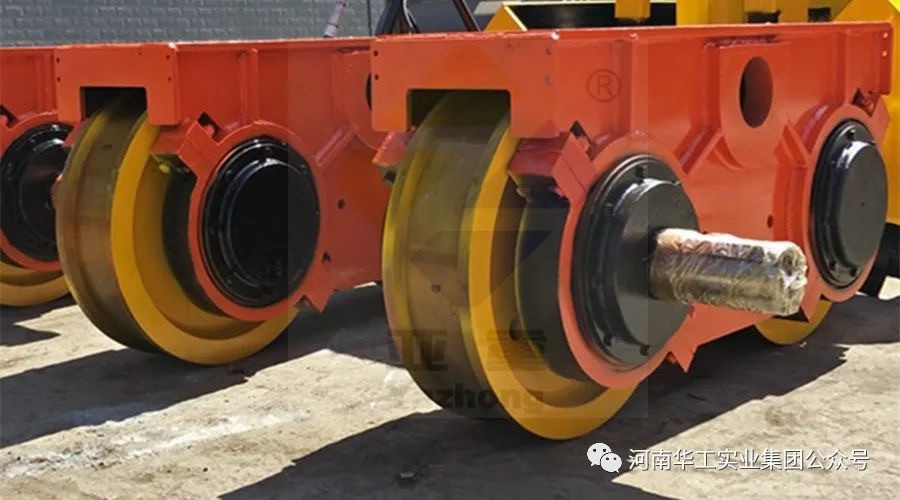First, the analysis of the gnawing rail phenomenon
Usually there is a certain gap between the wheel rim and the side of the track, in normal operation, they will not contact. But sometimes the wheel is not in the centre of the track running, which occurs wheel rim and track side contact (friction) of the gnawing phenomenon.
1. Wheel track gnawing phenomenon in the form of performance
(1) The side of the track or wheel rim on the inner side of the spot marks, serious traces of burrs or drop iron filings.
(2) When the bridge crane is travelling, the gap between the wheel rim and the track is obviously changed in a short distance.
(3) When the bridge crane is in operation, the body of the vehicle produces crookedness and the wheels go out of alignment.
(4) A loud "hissing" sound of gnawing rail will be issued when the crane is running.
(5) Nibbling rail is particularly serious, the operation of the car will be issued "吭吭 "撞击声, and even climb the rail.
2. Wheel nibbling rail caused by the adverse consequences of
(1) shorten wheel life. Under normal circumstances, intermediate (A4~A5) working level of the bridge crane, its wheels can be used for more than 15 years; heavy level (A6~A8) and metallurgical bridge crane wheels can be used for about 8 years. But for some bridge cranes with more serious gnawing rails, the wheels can only be used for 1~2 years or even a few months.
(2) Accelerate track wear. Gnawing the lateral force generated by the track can make the track position shift until it can not be used.
(3) Increase running resistance. Increase the motor power consumption and the transmission load of the mechanism.
(4) Deterioration of plant loaded condition.
3. The degree of bridge crane track gnawing
(1) Mild track gnawing. The controller is slow to start in first gear, and the inertia running distance is short after stopping.
(2) Moderate track gnawing. The controller does not start in the first gear, starts slowly in the second gear, and when it stops, sometimes there is no inertia running, and the rim wears out quickly, and there is a rolled edge.
(3) Severe track gnawing. Controller second gear does not start, reverse running l 0m or less, the car body skewed to reach the maximum value and began to gnaw the rail.
4. Gnawing the reason analysis
(1) Two active wheel diameter difference is too large. If the bridge crane two active wheels of different diameters, each turn walking distance is not the same, the diameter of the side of the big gradually ahead, so that the car body skewed and produced by the gnawing rail.
(2) four wheel installation position is not rectangular corners, the same side of the two wheel centre is not in the same straight line, whether it is the active wheel or passive wheel, wheel skew will result in gnawing rail. Wheel position is a parallelogram four-vertex arrangement, diagonal Dl>D2, gnawing wheel in the diagonal position. Wheel position is trapezoidal four-vertex arrangement, gnawing rail position in the same straight line.
(3) Horizontal deflection of the wheels exceeds the deviation. Horizontal deflection of the wheel, that is, the tread centre line and the centre line of the track in the horizontal direction there is an angle. At this point, the wheel running speed V can be decomposed into two directions, one is parallel to the wheel track Vx, so that the car body running forward; one is perpendicular to the wheel track Vy, so that the car body produces lateral sliding, resulting in wheel gnawing rail. Reasons for horizontal deflection of wheels:
① Due to the two sets of wheels assembled with inconsistent degree of tightness and produce different resistance, so that the drive motor is not synchronised, resulting in the car body skewed, the formation of wheel gnawing rail.
② If the difference between the two sides of the motor speed is too large, the car body will go diagonal and gnawing rail.
③ If the two sets of unit brake adjustment of different tightness, braking will make the car body skewed and gnawing rail.
④ The gear clearance of the two sets of transmission mechanism is different, and the key of the mechanism is loose, so that the two sets of transmission mechanism produce speed difference, causing the car body to go oblique and gnawing on the track.
⑤ The influence of unreasonable operation. Trolley often work on one side, so that the side of the big wheel pressure, resistance becomes larger and produce gnawing; start or stop too hard, will make the wheel idle slip, easy to cause gnawing.
(6) track level bending is too large, so that the wheel left and right activities become smaller; track elevation difference will make the car body to one side. (7) The wheels are installed in the wrong direction. Centralised drive or separately driven car in order to prevent track gnawing, sometimes the wheel to be made of 1:10 taper, installation of the small end should be on the outside, otherwise it will cause track gnawing.
(4) large car track installation is not correct, does not meet the technical requirements of the installation, resulting in tolerance overshooting, causing the wheels to gnaw the rail.

Second, exclude the measures of track gnawing
PREVIOUS:How to replace the wire rope of a crane reel set NEXT:Basic knowledge of crane wheel forgings
Contact: Mrs.Peng
Phone: 86-15910902294
E-mail: pengying@hjwm.com.cn
Whatsapp:+86 13713229714
Add: 140 meters north of Dongyangze Road, Guiling Avenue, Changyuan City, Xinxiang City, Henan Province,China
We chat
